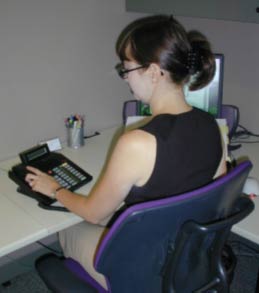Last Revised: July 29, 2025
The following are common problems we see when evaluating workstations, and possible solutions.
Twisting and leaning forward to view documents while working on the computer causing awkward neck, back and shoulder postures.
Solution:
Use an in-line copy holder when working from documents.
Resting wrists on desktop when working on the keyboard or mouse causing awkward wrist postures.
Solution:
Lower feet on the keyboard and use a soft wrist rest for the keyboard and mouse.
Reaching for frequently used items causing awkward arm and shoulder postures.
Solution:
Keep frequently used items within an easy reach.

Reaching for the mouse causing awkward shoulder and arm postures.
Solution:
Position the mouse close to the keyboard. Place the mouse directly in front of you when performing mouse intensive tasks (i.e. web browsing.)
Reaching for items located on overhead shelves causing awkward arm and shoulder postures.
Solution:
Stand to retrieve items off a shelf.
Sitting too low causing awkward wrist postures when typing and mousing.
Solution:
Raise the chair and use a footrest to position yourself at the proper typing height or purchase a keyboard tray.
Laptop computers do not allow the keyboard and monitor to be at the correct height causing awkward shoulder, neck and back postures.
Solution:
Add a separate keyboard and mouse and raise the laptop monitor to the proper viewing height.
Positive slope of keyboard tray causes awkward wrist postures.
Solution:
Position keyboard tray flat or slightly negative.
Placing the keyboard on a keyboard tray and the mouse on the desk causes awkward arm and shoulder postures.
Solution:
Place keyboard and mouse on the same surface and close to each other.
Cradling the telephone handset on your shoulder causes awkward shoulder and neck postures.
Solution:
Use the “hands free” option on your telephone or use a headset when speaking on the telephone while accessing the computer.
Working in an “L-shaped” corner causes awkward shoulder and arm postures.
Solution:
Use a corner extension to position the keyboard and mouse within an easier reach.
Sitting forward in the chair while working, providing no lumbar support.
Solution:
Sit fully back in the chair when working. Adjust the depth of the seat pan, the angle of the back or use a lumbar cushion.